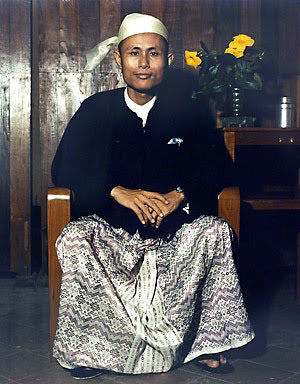myanmar greatest leaders
general aung san

In the long and turbulent history of Myanmar, one name stands above all — General Aung San, the man who gave birth to a nation. He was a visionary who fought both colonial rule and fascism, negotiated freedom with an empire, and laid the foundations for a democratic Burma. Though his life was cut tragically short, his spirit became the cornerstone of modern Myanmar.
👶 Early Life and Education (1915–1932)
Keyphrase: “Aung San early life”, “Aung San education”
Aung San was born on February 13, 1915, in Natmauk, a small town in central Myanmar’s Magway Region. His father, U Pha, was a lawyer, and his mother, Daw Suu, was known for her wisdom and compassion. He was the youngest of nine children, growing up in a humble yet educated household that valued patriotism and knowledge.
As a child, Aung San showed exceptional intelligence and leadership. He studied at Yamethin National High School and later at Rangoon University (now the University of Yangon), where he quickly became involved in student activism. His deep sense of justice and desire for freedom blossomed during these years, as Burma suffered under British colonial rule.
🎓 Rise as a Student Leader (1935–1939)
Keyphrase: “Aung San student movement”, “Dobama Asiayone”, “Aung San political awakening”
While at Rangoon University, Aung San emerged as a key figure in the growing anti-colonial movement. In 1936, he helped lead the famous student strike that protested British exploitation and university oppression. This bold act made him a national hero among young Burmese.
He soon joined the Dobama Asiayone (We Burmans Association) — a nationalist group fighting for independence. There, he earned the title “Bogyoke” (General) and met many who would later become pillars of the independence struggle. Aung San’s passion, eloquence, and fearlessness made him a natural leader of the new generation.
⚙️ Revolution and the Fight for Freedom (1940–1942)
Keyphrase: “Aung San Burma Independence Army”, “Aung San Japan alliance”, “Aung San WWII”
By 1940, the winds of war were blowing across Asia. Seeing an opportunity to fight colonial power, Aung San fled secretly to China, where he sought help from the Chinese Communists to free Burma. But he was intercepted by the Japanese, who offered support for his cause — at a price.
Aung San accepted Japan’s offer, believing it a necessary step toward independence. Along with 29 other young nationalists — the Thirty Comrades — he received military training in Japan. In 1941, they returned to form the Burma Independence Army (BIA), fighting alongside the Japanese to drive out the British during World War II.
⚔️ From Alliance to Betrayal (1942–1945)
Keyphrase: “Aung San and Japan”, “Aung San independence struggle”, “Aung San BIA”
In 1942, Japanese forces invaded and occupied Burma with help from Aung San’s BIA. Initially hailed as liberators, the Japanese soon revealed their imperial ambitions. Burma was turned into a puppet state, and its people faced suffering under Japanese control.
Aung San realized the betrayal. By 1944, he secretly formed the Anti-Fascist People’s Freedom League (AFPFL), uniting communists, socialists, and nationalists against Japan. On March 27, 1945, Aung San led the BIA — now renamed the Patriotic Burmese Forces — in a historic rebellion against the Japanese. That day became known as Armed Forces Day (now Tatmadaw Day), marking the birth of Myanmar’s modern army.
🇬🇧 Negotiating Independence (1945–1947)
Keyphrase: “Aung San independence of Myanmar”, “Aung San British negotiation”, “Panglong Agreement”
After the war, Aung San emerged as Burma’s undisputed leader. He negotiated with the returning British authorities to secure full independence. In 1946, he became Deputy Chairman of the Executive Council of Burma, effectively serving as Prime Minister under British oversight.
But his most remarkable achievement came in February 1947, when he signed the Panglong Agreement with leaders of the Shan, Kachin, and Chin ethnic groups — uniting them under one nation with promises of equality and autonomy. This agreement laid the foundation for the modern Union of Burma.
Aung San’s leadership during this period was a blend of diplomacy, courage, and vision. His dream was clear: a free, democratic, and united Burma built on equality and justice.
⚰️ Tragic Assassination (July 19, 1947)
Keyphrase: “Aung San death”, “Aung San assassination”, “Martyrs Day Myanmar”
Just as independence was within reach, tragedy struck. On the morning of July 19, 1947, during a cabinet meeting at the Secretariat Building in Yangon, armed men stormed in and opened fire. Aung San and six of his ministers were killed instantly.
The mastermind behind the assassination was U Saw, a rival politician. Aung San was only 32 years old. His wife, Khin Kyi, and their children — including his daughter Aung San Suu Kyi, who would later become a global icon of democracy — were left to carry his legacy.
Myanmar mourned deeply. July 19 became Martyrs’ Day, honored every year with silence, flags, and flowers to remember the man who gave his life for freedom.
🕊️ Legacy of the Father of Modern Burma
Keyphrase: “Aung San legacy”, “Father of modern Burma”, “General Aung San history”
Though his time was brief, General Aung San’s impact was eternal. He unified Burma’s ethnic groups, inspired its youth, and negotiated its freedom from one of the world’s greatest empires — all before his mid-thirties.
His image still adorns Myanmar’s currency. His speeches remain quoted in schools. And his vision — of a democratic and united nation — continues to inspire generations of Myanmar’s people.
He once said:
“I want our people to be masters of their own destiny, not slaves of others.”
Those words still echo in the heart of Myanmar — a reminder of the dream Aung San lived and died for
